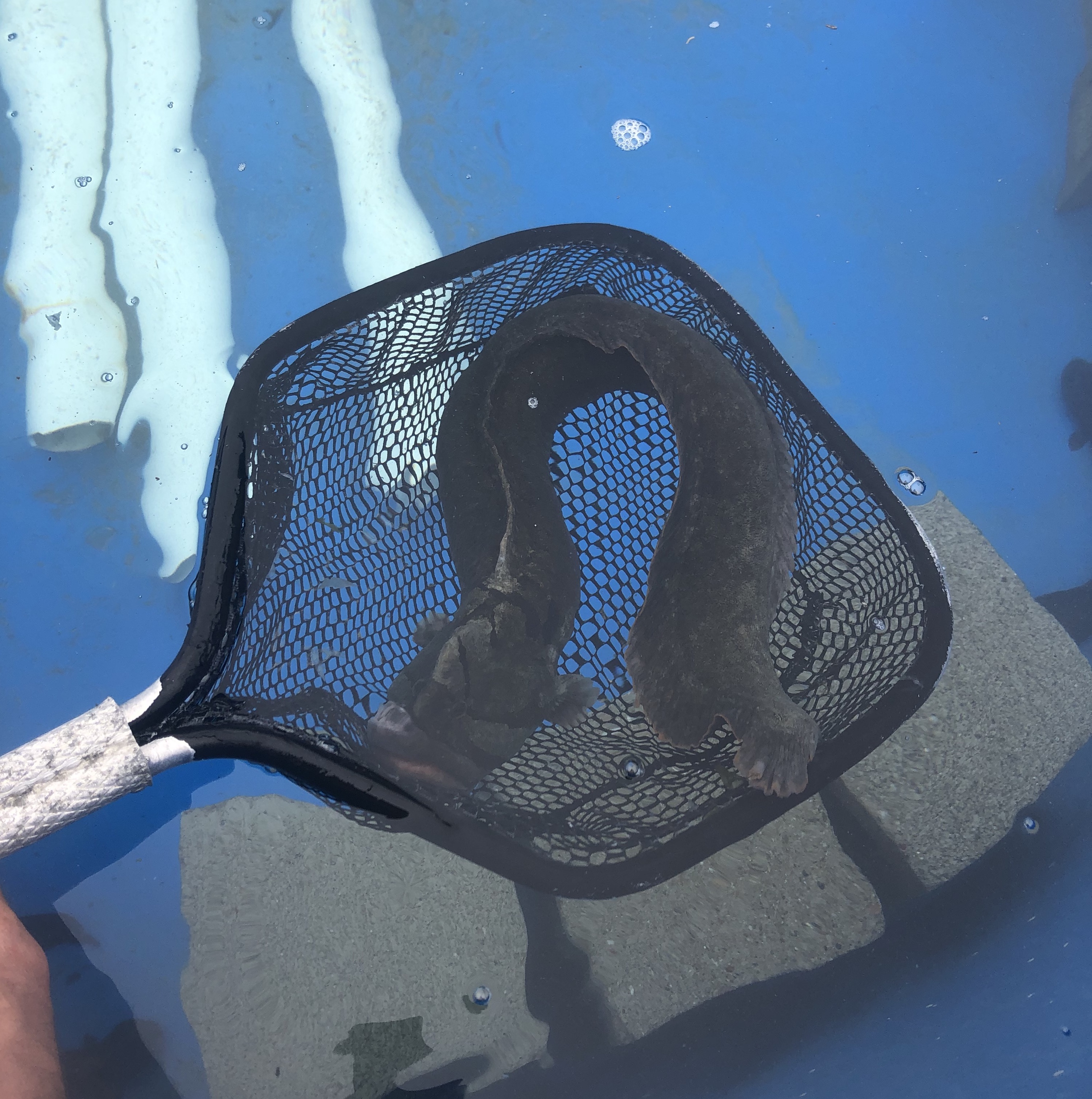What has big lips, a memorable name, and might one day be a fixture on California sushi menus? The monkeyface prickleback! This white-fleshed fish is an excellent substitute for Unagi, or freshwater eel. Populations of that popular delicacy have declined dramatically due to wild harvest, climate change, and other human-caused stressors. European, Japanese and American eels are all listed as endangered. But monkeyface prickleback has the potential to be grown sustainably in captivity, and some think it could be a great candidate for aquaculture.
 Monkeyface pricklebacks are West Coast natives, and are found in near-shore rocky reef and tidal habitats from Oregon to Baja California, Mexico. Long and eel-like, these fish can grow up to 30 inches in length and live for 18 years. Mature monkeyface pricklebacks are herbivores, feeding mostly on red and green algae, and are the only large-bodied herbivorous fish in Central and Northern California. This makes them a more sustainable fish to use in aquaculture compared to other species with differing diets. Most fish used for aquaculture have a carnivorous or omnivorous diet, requiring fish feed made with proteins from other fish or land-based sources. This increases the carbon footprint of the farmed fish, drives up costs, and makes the aquaculture less sustainable.
Monkeyface pricklebacks are West Coast natives, and are found in near-shore rocky reef and tidal habitats from Oregon to Baja California, Mexico. Long and eel-like, these fish can grow up to 30 inches in length and live for 18 years. Mature monkeyface pricklebacks are herbivores, feeding mostly on red and green algae, and are the only large-bodied herbivorous fish in Central and Northern California. This makes them a more sustainable fish to use in aquaculture compared to other species with differing diets. Most fish used for aquaculture have a carnivorous or omnivorous diet, requiring fish feed made with proteins from other fish or land-based sources. This increases the carbon footprint of the farmed fish, drives up costs, and makes the aquaculture less sustainable.
A California Sea Grant-funded research team at Moss Landing Marine Laboratories is working with Monterey Bay Seaweeds, who provide the algal feed and technical knowledge on the cultivation of seaweed feed, to study these unique fish. Their goal is to figure out how to grow these fish in captivity, and work with aquaculture farms to determine if the species could be commercially viable.
Graduate Student Matthew Hoehn shared his experience collecting fish for the project, “Over the past five months I have collected, as well as coordinated with local commercial fishermen to collect, a total of 126 pricklebacks from various intertidal locations in California. To collect the fish I utilized a fishing method called "poke poling.” This fishing method was used by Native Americans and involves using a baited hook at the end of a pole, and then poking the pole into cracks and crevices in and around the intertidal, where the monkeyface resides.”

Working with Moss Landing researchers Scott Hamilton and California Sea Grant Extension Specialist Luke Gardner, Hoehn is caring for these 126 fish to establish a study population at Moss Landing Marine Laboratory’s aquaculture facility. Here the team is conducting experiments to answer questions about the monkeyface prickleback’s reproductive cycles and diet, as well as determine if they are as good of a candidate for aquaculture as they seem. They hope to eventually have the fish spawn in captivity, an important step for creating a sustainable captive breeding population.
“The real advantage to herbivory in aquaculture is that the fish has already evolved to digest algae,” said Gardner. “It doesn't have all the digestion difficulties that other carnivorous fish may have when we try to convince them to be vegan for the sake of wild forage fish stock from where fish meal and fish oil originate.”
We are excited to learn the results of Matthew and the monkeyface prickleback team’s research.
Monkeyface prickleback quick facts:
-
Their long bodies allow them to hide in caves and crevices along coastal rocky-bottom habitats.
-
They are homebodies, rarely venturing more than 15 feet away from their home cave.
-
A mature female can lay up to 46,000 eggs into one egg mass that she sticks to a rock
-
Adult fish will guard their egg mass, though it is still to be determined if males or females (or both) do the guarding
-
As long as they are kept moist and can gulp air, monkeyface prickleback can survive out of the water for at least 35 hours, maybe longer